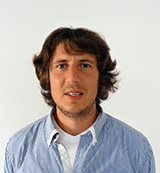Leonid Pavlov
Leonid currently works as a Development Engineer in the Projects department of ATG Europe in Noordwijk, The Netherlands and graduated in the Aerospace Structures and Computational Mechanics Group in 2012.
“During my bachelor studies, the charisma and enthusiasm of my university tutors, among which Christos Kassapoglou, Gillian Saunders, Mostafa Abdalla, Sergio Turteltaub, Roeland de Breuker and Eddy van den Bos, influenced the way I saw aerospace structures (and the whole ASM department). Adding to that the fact that I had lots of fun studying structural mechanics during my Bachelors studies and I really liked the above mentioned people I decided to follow the structures and materials MSc track.
Without realizing it at first, I think my best experience during my MSc studies was when I failed the final project for the course Analysis and Optimization of Composite Structures taught by Christos Kassapoglou.
I grossly underestimated the time required for it and tried to finish it practically overnight, big mistake. While I didn’t fail the whole course because of this final project, I was quite unhappy with the final grade for it, due to all the hard work I put into it prior to the final assignment. Dr. Kassapoglou was kind enough to offer me a chance to fix my mistake by doing a different project on a hardcore math-intensive structures topic, which I gladly took, without realizing what I was getting myself into. I ended up spending a huge amount of time working on this project and in the end pulling it off. Along the way I learned a tremendous amount of exciting new things, derived a couple of new mathematical formulae and came up with a program that accurately calculated deflections of composite plates which could be used in low speed impact computations using various types of assumptions.
This exciting and rewarding result is not the main thing I took from doing this assignment. Along the way, I got fascinated by analysis of composite structures and the various mathematical approaches that exist for such analyses. I got to love working on such topics and realized that this is exactly what I wanted to do further. The bond I developed with Dr. Kassapoglou during this time defined who I wanted to be my future MSc thesis supervisor and it helped me greatly in my career as well, because these days we still cooperate intensely on a number of research topics. This happened largely due to the mutual respect we gained during the time I was working on my “resit” final project, in the end this shaped my life in ways I could never imagine.
ATG Europe does a lot of work for the European Space Agency and its suppliers, so we mainly deal with space engineering projects, but we get to do lots of exciting work in other fields as well. In my work as a development engineer my main activity is leading the technology developments for lattice and grid-stiffened composite structures. This includes developing design and analysis methods as well as manufacturing and testing methodologies for this innovative composite architectures and products made using them. Part of the work consists in identification of business opportunities for this structural architecture, performing elaborate feasibility studies for specific products and then realizing the actual parts, along the way solving the challenges associated with the application of this innovative architecture. Additionally I get to work on various projects in the space engineering field, including design, static and dynamic analyses of spacecraft structures and so on. The atmosphere in our department is start-up like so the motivation of all the colleagues is extremely contagious. The work is demanding, but in return one gets to work on all sorts of things from systems engineering to manufacturing technology and structural analysis methods development.
My only advice to future students would be: Go for it! If you have some affinity for structures, you will not regret it and you will be able to find something to your liking within the track and eventually specialize in it.
After finishing the study, you can choose practically any engineering field to work in (aircraft, space, mechanical, wind, industrial, etc.) and refocus towards this field easily. In doing so you will have lots of insights other people would never have without having studied aerospace structures. In my experience, people that followed the track, always managed to find something they enjoy working on and they get to use the invaluable insights they have obtained during their studies, thus making a difference.
The study can be demanding for some, but it surely will be extremely rewarding too!”
